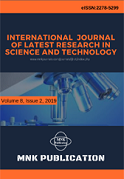DOI:10.29111/ijlrst ISRA Impact Factor:3.35, Peer-reviewed, Open-access Journal
Research Paper Open Access
International Journal of Latest Research in Science and Technology Vol.4 Issue 4, pp 31-35,Year 2015
Correspondence should be addressed to :
Received : 10 August 2015; Accepted : 20 August 2015 ; Published : 31 August 2015

| Download | 125 |
|---|---|
| View | 180 |
| Article No. | 10537 |
The aim of the current study was to record the various measurements of Posterior Cruciate Ligament (PCL) on tibial surface in both sexes and both legs in elderly aged Chinese patients who were scheduled for undergoing Total Knee Arthroplasty (TKA) and to evaluate the results statistically. Methods: 75 tibial cut-off bones of Chinese patients were collected during TKA intra-operatively. Among them, in male 10 samples were from left and 3 from right knee, and in female 34 samples from left and 28 from right knee, who varied in age from: 45 to 75 years old. Those samples were evaluated in order to make measurements from tibial insertion of PCL to anterior region of the tibial plateau, from tibial insertion of PCL to center of tibial plateau, from center of the tibial insertion of PCL to the medial region of the tibia and from center of the tibial insertion of PCL to the lateral region of the tibia. Results: The anteroposterior diameter of tibial plateau is 43 mm; tibial insertion of PCL is 34 mm from the medial cortex and 36 mm from lateral cortex of tibia. Conclusion: The PCL has extensive insertion on Tibial Plateau. Our study concludes that the tibial insertion of PCL is slightly medial on the tibial plateau in both left and right knees in both male and female. So the location of center of the tibial insertion of PCL has no significant differences in terms of gender and side distribution among elderly Chinese population.
Copyright © 2015 Chandan Kumar Jayswal et al. This is an open access article distributed under the Creative Commons Attribution 4.0 International (CC BY 4.0) license which permits unrestricted use, distribution, and reproduction in any medium, provided the original work is properly cited.
Chandan Kumar Jayswal, Md. Shahidur Khan,Cong Chen, Yuanjun Teng,Meng Wu, Yayi Xia , " Anatomical Study Of Tibial Insertion Of Posterior Cruciate Ligament In Elderly Aged Chinese Population ", International Journal of Latest Research in Science and Technology . Vol. 4, Issue 4, pp 31-35 , 2015

MNK Publication was founded in 2012 to upholder revolutionary ideas that would advance the research and practice of business and management. Today, we comply with to advance fresh thinking in latest scientific fields where we think we can make a real difference and growth now also including medical and social care, education,management and engineering.

We offers several opportunities for partnership and tie-up with individual, corporate and organizational level. We are working on the open access platform. Editors, authors, readers, librarians and conference organizer can work together. We are giving open opportunities to all. Our team is always willing to work and collaborate to promote open access publication.

Our Journals provide one of the strongest International open access platform for research communities. Our conference proceeding services provide conference organizers a privileged platform for publishing extended conference papers as journal publications. It is deliberated to disseminate scientific research and to establish long term International collaborations and partnerships with academic communities and conference organizers.